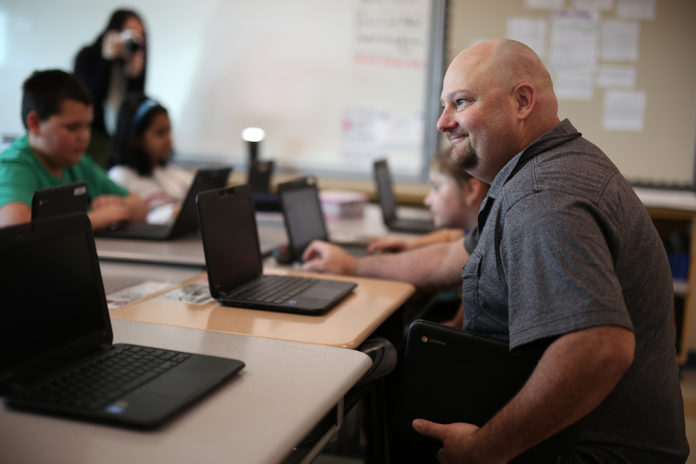It’s no exaggeration to say technology has significantly changed the education experience. Virtually gone are the days of students reaching into their desks for pen and paper, as more schools continue to equip both teachers and students with more advanced tools such as laptops and tablets. The advantages are plentiful: greater interactivity and collaboration, access to broader information, and the ability to learn valuable tech-based skills.
According to a winter 2016 document by the Ontario Ministry of Education, 21st Century Competencies, there is emerging evidence on how the use of technological innovations can optimize and positively transform the learning experience. In addition, learners’ expectations continue to evolve and teachers are seeing a growing demand by students for an education system that is more connected and relevant to their everyday lives. Equipping the Next Generation
However, ensuring your school is properly equipped to meet these demands can be a challenge. Schools need to make practical decisions so that students can have up-to-date solutions that can handle strenuous education needs, while remaining within the allotted budget. It was a challenge that the Superior North Catholic District School Board (SNCDSB) welcomed when it made the decision to implement an ambitious IT upgrade to its nine elementary schools across Northern Ontario.
“One of our key priorities as we work towards 21st Century global competencies is to support student achievement and well-being and we feel one of the most effective ways of achieving that is by constantly finding new and innovative ways for student engagement,” says Billy Luby, IT Supervisor for the SNCDSB. “We strongly encourage a culture of visible learning by getting the children excited about the learning environment and encouraging them to have fun while they learn. Technology gives us the opportunity to take the learning process to a whole new interactive level. Another goal of ours is to have a one-to-one ratio of students to device, which we believe will improve their learning.”
One of the SNCDSB’s priority objectives is for the Education Technology Department to work collaboratively with the Student Achievement Department to support student achievement and well-being. Google Chrome Books had been provided to students for the 2015/2016 school year, and had been met with positive reaction. That success convinced the SNCDSB in 2016-17 to expand its digital footprint and provide tablets to all grades. In working proactively, the SNCDSB had the advantage of knowing exactly the kinds of requirements students and faculty needed, based on feedback from online surveys conducted regularly. This data collection gave SNCDSB a clearer understanding of classroom needs and the types of software and hardware required.
Billy Luby and the Ed Tech Team worked with CDW Canada to make the students and educators’ dreams a reality. The company had already worked with the SNCDSB for many years, and used its vast experience in the education sector and with other school boards to advise on and supply the new implementation Implementing the Solution
Over the summer of 2016, the SNCDSB and CDW Canada began preparing the nine schools for the refresh. On the backend, new Lenovo servers were installed for their power, flexibility, reliability and ability to be easily managed. A network linking all nine schools was then created using HP access points, controllers and switches. For network optimization and cost-savings, VMware was used to virtualize the environment, and Veeam Backup & Replication helped to protect valuable data.
While the network was being created and secured, thought was being given to the devices the students will be wielding. The Ed Tech Team knew the use of Google Classroom was top of mind for many teachers. The application is well-known for its ability to instantly create classes and assignments that could be quickly distributed to students – who could then immediately provide feedback. The Board had even held a Google Summit for students during the 2015/2016 school year – and once again in 2016/2017 – to showcase and educate the students and teachers on the technology. Knowing Google Classroom was a priority, CDW Canada provided approximately 600 Google Chromebooks for students from Grades three to eight. Younger students were supplied with Samsung tablets, as it was discovered they respond better to touch-screens than traditional keyboards. In addition to the Google applications, CDW Canada also installed VMware AirWatch for easy and efficient mobile device management. The Rewards of Enhanced Education
When the children returned from summer holiday in September 2016, the schools were more than ready. Now armed with either a tablet or Chromebook, students benefit from more interactive and inclusive lessons, and receive quicker feedback from teachers. Faculty, in turn, have the ability for better organization and planning.
The implementation has yielded resounding success. The SNCDSB received numerous letters from students thanking them for the new equipment. The Ed Tech Team and Student Achievement Division has seen increased morale and a fresh eagerness to learn from students, which may have contributed to a noticeable growth in EQAO scores from the previous year.
Billy believes that much of the success was through the partnership with CDW Canada and their ability to offer a quality selection of equipment paired with valuable consultation. “Being a smaller board, we don’t have a large resource pool to draw from, but many times I was able to consult with CDW Canada’s in-house experts on new and upcoming technology that would be suitable to our needs,” says Billy. “They are always able to advise on current education trends, informing us what advantages there are for students, and how that can be applied to our specific needs. Our goal of supplying each student with a device would simply not have been met, on time and on budget, had it not been for CDW Canada’s input and recommendations.”
“Technology gives us the opportunity to take the learning process to a whole new interactive level.”
By Pedro Cabezuelo







